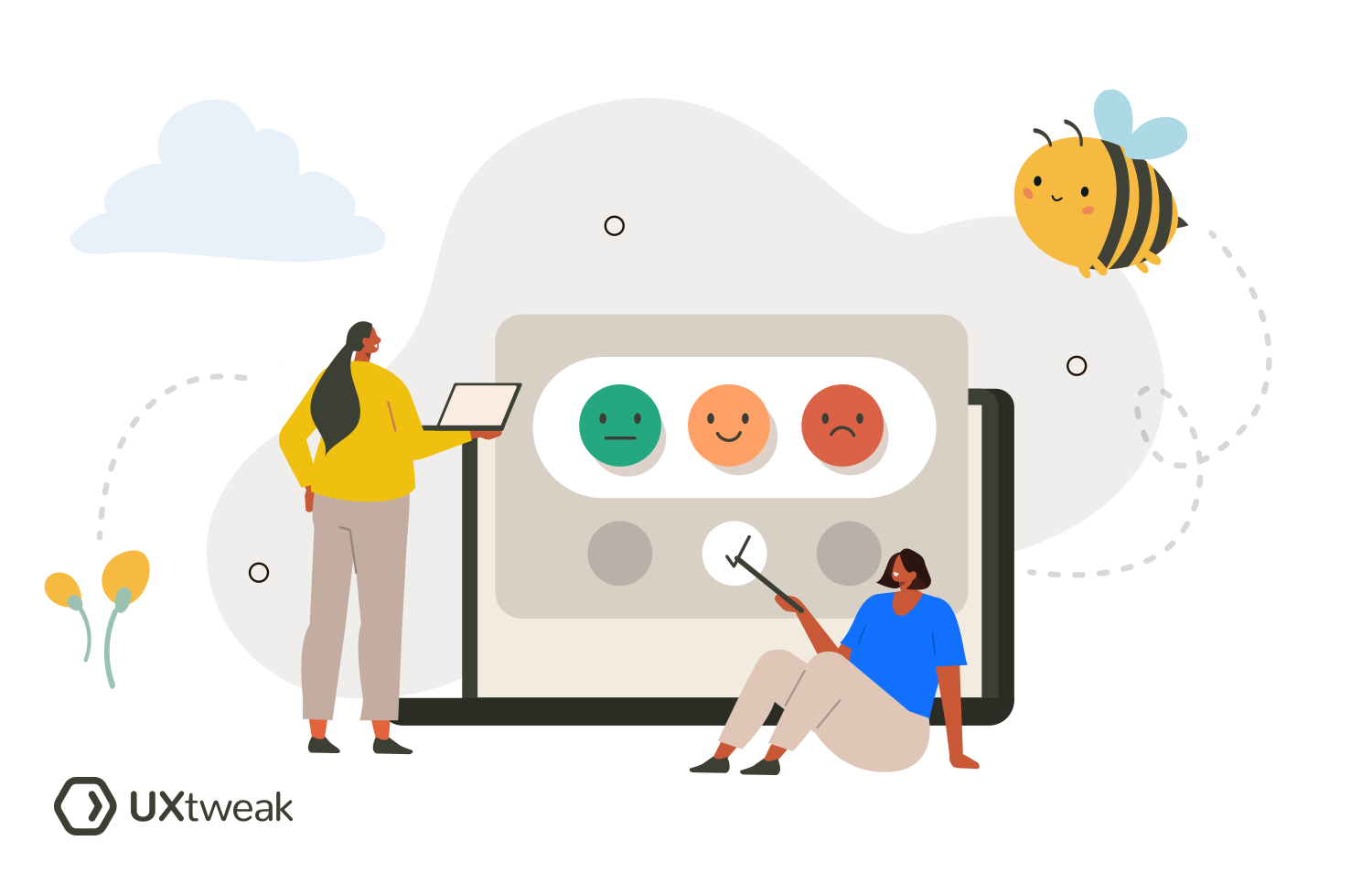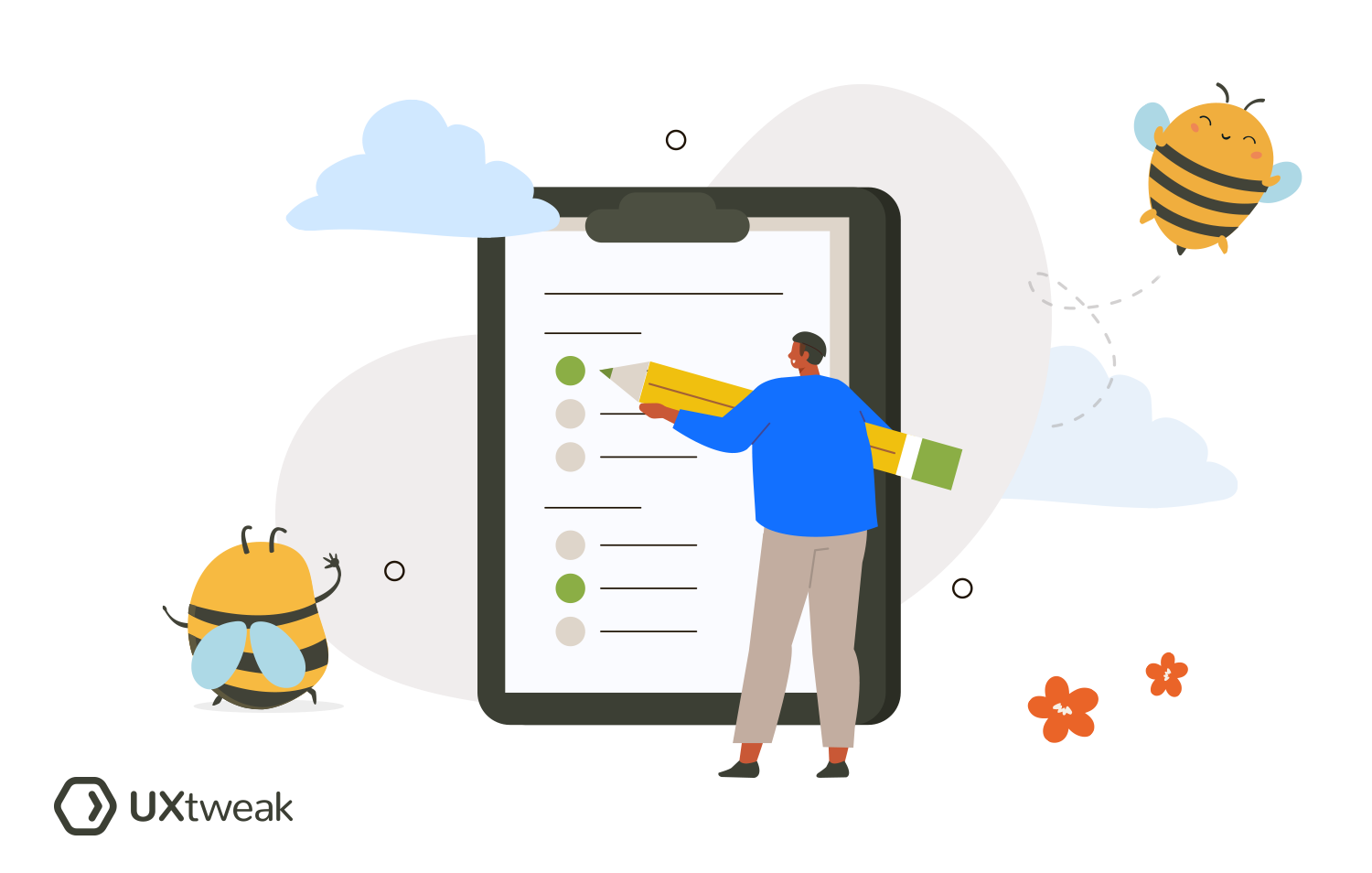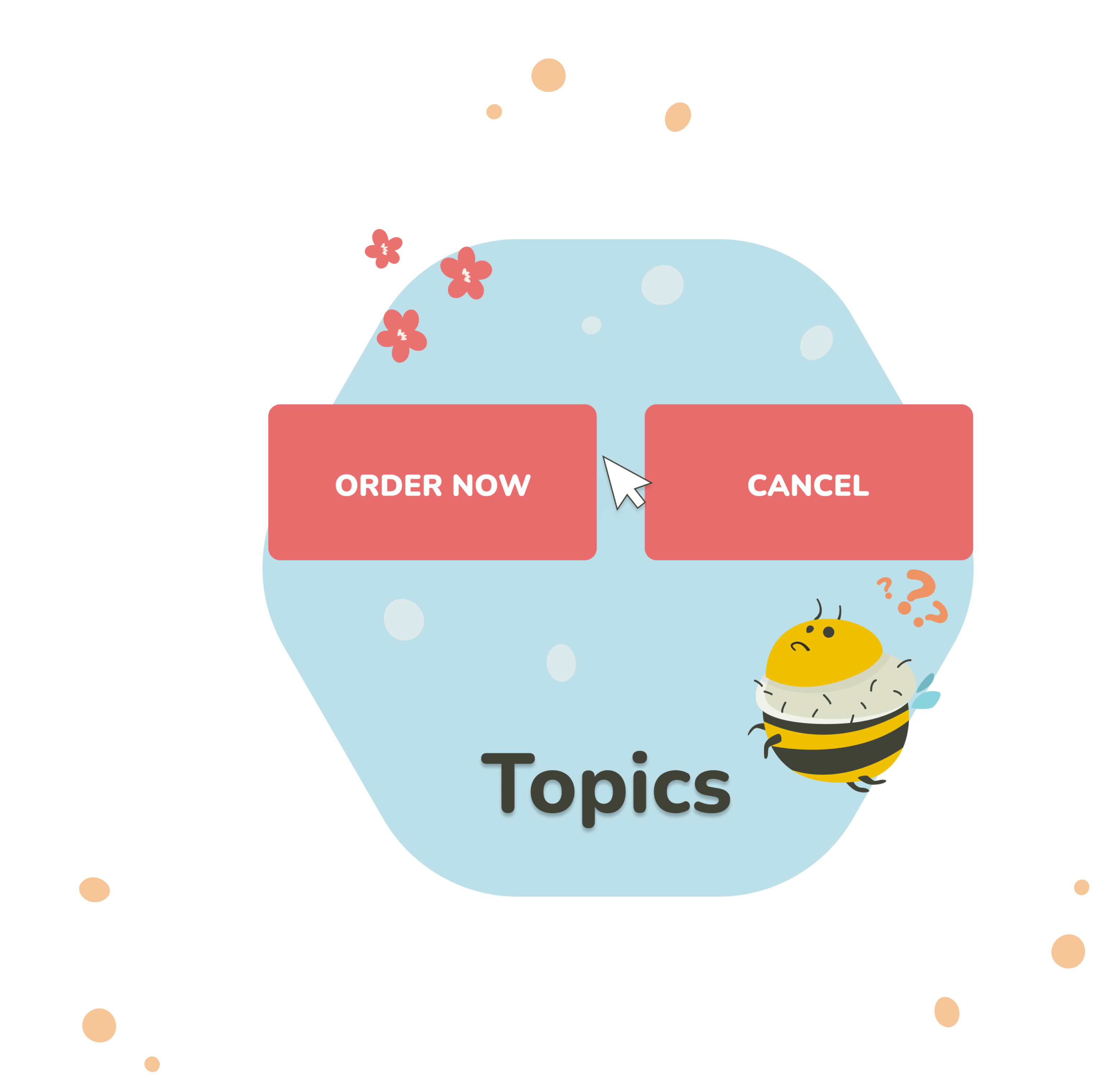We already know that customer feedback is the foundation of any improvements done on your digital product. However, to collect this feedback and be able to analyze it effectively you need to ask good customer feedback questions that encourage people to share their opinions.
Let’s dive into the world of customer feedback questions together and see how you can master the art of questioning to generate more meaningful insights from customer feedback.
What customer feedback questions to ask?

Here are some common categories of customer feedback questions:
- Questions to get to know your customers
- Questions to understand your customers’ needs
- Questions to improve a product or service
- Questions to measure customer experience
- Questions to improve your marketing strategy
- Customer feedback questionnaire related to a specific page
- Questions to ask about customer service
- Questions to learn about your competition
- Questions to validate assumptions
Let’s take a look at some example questions for each category 👇
Questions to get to know your customers
➡️ These are the general questions that you ask with the goal to obtain more information about your customers, their background, demographics and relation to your product.
Questions from this category can help you find out how they discovered your product, what they use it for, how often they use it and so on.
- Can you tell us a little bit about yourself? (age, occupation, hobbies)
- What’s the one thing you want to achieve when you visit our website?
- How did you first hear about our product?
- How often do you purchase products/services in our category?
- What factors are important to you when choosing products/services in our category?
Questions to understand your customers’ needs
➡️ To understand your customers’ needs better, we recommend asking open-ended questions about the problems your product solves for them.
Ask what primary features they use, what features they wish you could add and what else you can do to improve their experience.
- What problems are you trying to solve by using our product/service?
- What aspects are most important to you in a product/service like ours?
- Are there any additional features that you would like to see in our product?
- How can we make our product more useful for you?
- If you could change one thing about our product, what would it be?
Questions to improve a product or service
➡️ With these kinds of questions you want to encourage customers to talk about any possible frustrations or confusions your product caused them. That’s because these are exactly the areas that you’ll need to prioritize when making improvements.
Additionally, ask what your product is lacking, to find out what other essential features you need to implement.
- Have you encountered any problems while using our product?
- Is there anything you find confusing about our product?
- Can you share your thoughts on our latest update/feature?
- How can we improve your experience with our product?
- What changes would you recommend to improve our product?
- If you could add one feature to the product, what would it be?
- Is there anything our product is lacking?
Questions to ask to measure customer experience
➡️ These questions help you measure customer experience and generate quantitative insights using some of the established metrics, such as Net Promoter Score (NPS), Customer Satisfaction Score (CSAT) and Customer Effort Score (CES).
- NPS: On a scale of 0-10, how likely are you to recommend our product to a friend?
- CSAT: How would you rate your overall satisfaction with our product/service?
- CSAT: How would you rate your recent interaction with our customer service team?
- CES: How easy was it to find what you were looking for?
- CES: How much effort did you personally have to put forth to handle your request?
Questions to improve your marketing strategy
➡️ Customer feedback is not only useful for collecting insights on your product and its functionality, but also evaluating the messaging and communication strategy of your marketing team.
The questions below will help you gather feedback on your marketing efforts and find out what type of content you need to produce more of.
- How do you prefer to receive updates or news about our products/services? (email, social media, etc.)
- Which of our marketing campaigns do you remember most?
- What are your thoughts on our website/Instagram (any other social media) page?
- Are our promotions/offers meeting your expectations?
- What type of content would you like to see more of?
Customer feedback questionnaire related to a specific page
➡️ Some of these questions can become a part of your on-site questionnaire for assessing the experience provided by a specific web page.
They are designed to help you better understand how customers and website visitors perceive specific content and whether or not they find it helpful.
- Was the information on this page clear and easy to understand?
- Was the information on this page helpful to you?
- Did you encounter any issues while navigating through this page?
- Is there anything you would like to add or change about this page?
- How could we improve the user experience on this page?
Questions to ask about customer service
➡️ The following customer feedback questions can help you assess the quality of your customer service and come up with additional ways to improve it.
- How would you rate your recent customer service experience with us on a scale of 1-10?
- How quickly was your issue resolved by our customer service team?
- How could we improve your experience with our customer service?
- Did you feel heard and understood by our customer service representative?
- Was the solution provided to you by our customer service representative helpful?
Questions to learn about your competition
➡️ Your competitors and their offering are often the key to improving your own product.
Here are some questions to help you get more context on how customers perceive your competitors:
- What other brands in our category do you consider when making a purchase?
- What do you like about our competitors’ products?
- Are there features in our competitors’ products that you wish we had?
- What made you choose us over our competitors?
- How does our product compare to [competitor’s product]?
Questions to validate assumptions
➡️ Lastly, you can use some of the questions below to validate the assumptions your team makes about the product and the way customers use it.
When validating assumptions, make sure to remain unbiased in your questions’ wording and don’t try to lead the respondents towards a certain answer.
- We assume that most of our users value feature X over feature Y. Is this true for you?
- We think that our customers primarily use our product for X purpose. Is this the primary way you use our product?
- We assume that our customers would prefer a self-service portal for addressing common issues. Would this be beneficial for you?
- Do you agree with the statement [assumption]?
Why is a customer feedback questionnaire important?

Customer service questionnaire gives you a unique opportunity to quickly collect, analyze customer feedback and act on the obtained insights as fast as possible.
Here are some of the most common benefits a customer feedback questionnaire brings to your business:
- Learn more about customers: a questionnaire that is specifically designed to align with your research goals can help to understand customers better, generate more empathy towards them, and, therefore, come up with more impactful ways on how to improve the product while remaining user-centered.
- Measure customer satisfaction: by using some of the established CX metrics like NPS, CSAT or CES customer feedback questionnaire, you can obtain quantitative data about your customers, and use it to pinpoint problem areas.
- Find areas of improvement: Lastly, by constantly asking for feedback on your product you’re able to always be aware of any potential issues or suggestions that arise. That way you not only know what needs to be fixed, but can also generate ideas on how to make the product even better and stay ahead of the competition.
What are the best practices for writing a customer feedback questionnaire?

Keep it short and focus on what’s important
Respect your customers’ time and do your best to make the questionnaire as short and straight to the point as possible. Remember, that the longer the survey, the higher the dropout rate.
Only include the necessary questions that are important to your research and correspond to the goals of the feedback collection. If you’re unsure about whether or not to add an extra question, it’s probably not that important. Keep your surveys under 10 minutes and keep in mind that the quicker it is to complete – the better.
Start with easier questions
Beginning with simple, easy-to-answer questions can help to increase the completion rates of your questionnaire. A good rule of thumb is to start with demographic questions or simple rating scales before moving on to more complex open-ended questions.
Mix question types
To ensure the high completion rate use different question types. You can include open-ended questions, rating scales and multiple choice questions. This way you’ll be able to collect both qualitative and quantitative data, get access to a variety of insights and keep the respondents engaged throughout the whole questionnaire.
Avoid leading questions
A leading question is a question that encourages respondents to answer in a certain way based on the wording of the question. They’re designed to instill bias in respondents so that the results match the expectations of the author.
Sometimes we introduce this kind of bias to our questionnaires unintentionally, without being aware of it. Running a pilot test of your questionnaire can help to pinpoint and rewrite such questions, before the survey is administered to the customers.
Test before sending
Run a pilot test of your questionnaire before sending it out to customers. You can test it by sending it to a colleague that wasn’t involved in the process of questionnaire design.
This will help to estimate how much time it takes to complete the questionnaire and pinpoint any potential issues that may arise with it. A pilot test is also a great opportunity to assess the wording of your questions and make sure that there are no leading questions in your list.
Free customer feedback questionnaire templates

Why design your own questionnaire from scratch when you can just use a customer feedback questionnaire template?
Here are some of our best free picks that you can customize to your liking and use to save time on survey design:
- Jotform’s Product Customer Feedback Form
- Jotform’s Customer Service Survey Form
- Hubspot’s 5 Customer Satisfaction Survey Templates
- Qualtrics Customer Satisfaction Survey Template
- QuestionPro’s Customer Service Survey Template
- QuestionPro’s NPS Survey Template
- QuestionPro’s Product Satisfaction Survey Template
Customer feedback questionnaire examples
There are tons of customer feedback questionnaire examples you can find online. That’s because any successful company nowadays does their best to communicate with customers and collect their feedback on a regular basis.
A great example is Slack. Here’s how they ask customers for feedback on their app:

You can see here that the message is perfectly written to encourage a customer to complete the survey. They are using a friendly tone and simple language.
From the beginning, Slack makes you feel special by saying that you’re one of a small set of chosen people for this questionnaire. They also include information about how long the survey will take, which should always be a crucial part of your invitation.
Check out this page for more Customer Feedback Questionnaire Examples.
Wrapping up
In conclusion, designing a good customer feedback questionnaire is a vital step in ensuring the relevance of obtained insights. Remember, that an effective questionnaire should not only ask the right questions but also align perfectly with the goals of your research and business overall. Assuring that will guarantee you continuous improvement and growth.
To start collecting your customer feedback today, register for your UXtweak account and use our robust survey tool to design your customer feedback questionnaire!


